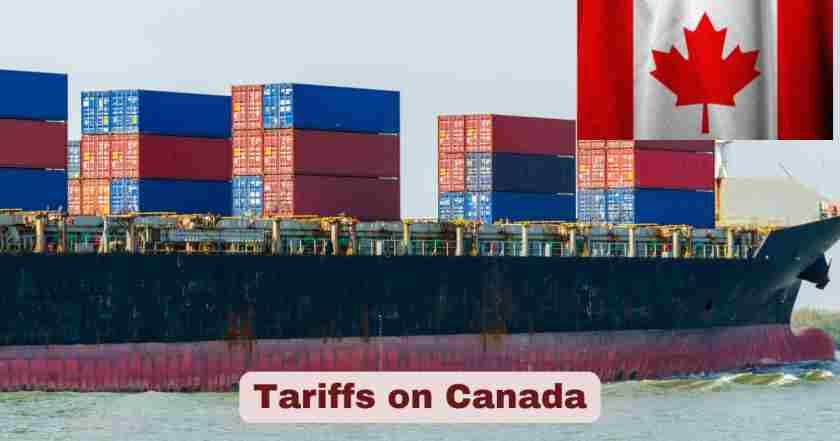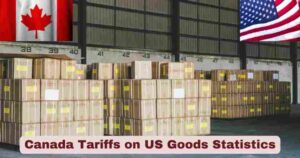Tariffs on Canada in 2025
The year 2025 has marked a significant turning point in Canada’s trade landscape, with unprecedented tariff developments reshaping the nation’s international commerce relationships. Canada’s response to international trade pressures has been swift and strategic, implementing robust countermeasures that reflect the country’s commitment to protecting its economic interests while maintaining its position as a global trading powerhouse.
Canada’s tariff policy in 2025 represents one of the most comprehensive trade responses in recent history, with the United States implementing 35% tariffs on Canadian goods effective August 1, 2025, escalated from the initial 25% rate. President Donald J. Trump signed an Executive Order increasing the tariff on Canada from 25% to 35%, with the higher tariff set to go into effect on August 1, 2025. This dramatic escalation was implemented under the International Emergency Economic Powers Act (IEEPA) to address national security concerns, demonstrating the intensifying nature of bilateral trade tensions and their impact on Canada’s economic sovereignty.
Interesting Stats & Facts About Tariffs on Canada 2025
| Tariff Facts Category | Key Statistics |
|---|---|
| Current US Tariff Rate | 35% on Canadian goods (effective August 1, 2025) |
| Previous US Tariff Rate | 25% (March 2025 – July 31, 2025) |
| USMCA Exempt Goods | 0% (goods qualifying under USMCA remain exempt) |
| Transshipment Penalty | 40% tariff on goods evading the 35% rate |
| Legal Authority | IEEPA (International Emergency Economic Powers Act) |
| Current Trade Deficit | $5.9 billion (June 2025 – Second Highest on Record) |
| Escalation Date | August 1, 2025 (35% implementation) |
| Export Recovery | 0.9% increase in June after April decline |
| US Export Reduction | 12.5% year-over-year decline to US |
| Services Trade | Deficit narrowed to $0.7 billion in June |
The implementation of US tariffs on Canadian goods in 2025 has created measurable impacts across multiple sectors of the economy, with the situation escalating significantly on August 1, 2025 when the US increased tariffs from 25% to 35% under the International Emergency Economic Powers Act (IEEPA). Goods qualifying for preferential tariff treatment under the United States-Mexico-Canada Agreement (USMCA) continue to remain exempt from the IEEPA Canada tariffs, while goods transshipped to evade the 35% tariff are subject to a higher transshipment tariff of 40%.
As of August 8, 2025, President Donald J. Trump signed an Executive Order increasing the tariff on Canada from 25% to 35%, with the higher tariff effective August 1, 2025. Canada’s trade deficit widened to $5.9 billion in June, representing the second highest on record, reflecting ongoing challenges in bilateral trade relationships. The 35% tariff rate now applied to non-USMCA qualifying Canadian goods has resulted in significant shifts in trade patterns, with exports to the United States declining by 12.5% year-over-year in June 2025. However, Canada’s services trade deficit narrowed from $0.9 billion in May to $0.7 billion in June, with services exports rising 1.0% to $18.0 billion, indicating adaptation in the services sector.
Import Tariffs on Canada Trade Statistics 2025
| Import Category | June 2025 Value (CAD Billions) | Monthly Change (%) | Annual Change (%) |
|---|---|---|---|
| Total Imports | $67.3 | +1.4% | -2.1% |
| US Imports | $37.8 | +2.6% | -8.3% |
| Non-US Imports | $29.5 | -0.3% | +5.7% |
| Industrial Machinery | $8.7 | +27.7% | +12.4% |
| Motor Vehicles | $6.2 | +2.9% | -11.9% |
| Consumer Goods | $9.8 | -4.8% | -6.2% |
| Energy Products | $3.4 | +1.2% | +8.9% |
| Metal Products | $4.1 | -7.8% | +18.6% |
| Services Imports | $18.7 | -0.2% | +3.2% |
Canada’s import landscape in 2025 reveals a complex pattern of adaptation and strategic diversification in response to evolving tariff structures. A one-time high-value oil equipment import had imports growing faster than exports, contributing to the deficit, with total imports reaching $67.3 billion in June 2025, representing a 1.4% monthly increase despite ongoing trade tensions. The data demonstrates Canada’s resilience in maintaining essential import flows while adjusting to new tariff realities. Imports from the United States totaled $37.8 billion, showing a 2.6% monthly increase but an 8.3% annual decline, indicating the long-term impact of tariff implementations on bilateral trade.
The most significant development in Canada’s import profile has been the 27.7% surge in industrial machinery imports, reaching $8.7 billion in June 2025, primarily driven by high-value equipment for energy infrastructure projects. Services imports edged down 0.2% to $18.7 billion while consumer goods imports declined by 4.8% to $9.8 billion, reflecting changing consumption patterns and potential supply chain adjustments in response to tariff pressures. The diversification strategy is evident in the 5.7% annual increase in non-US imports, valued at $29.5 billion, showing Canada’s successful efforts to reduce dependency on traditional trading partners while maintaining import volumes.
Export Tariffs on Canada Trade Revenue 2025
| Export Sector | June 2025 Value (CAD Billions) | Monthly Change (%) | Annual Change (%) |
|---|---|---|---|
| Total Exports | $61.6 | +0.9% | +2.2% |
| US Exports | $44.7 | +3.1% | -12.5% |
| Non-US Exports | $16.9 | -4.1% | +14.7% |
| Energy Products | $16.2 | +3.8% | -8.4% |
| Auto & Parts | $6.8 | -4.2% | -16.6% |
| Farm Products | $8.9 | +6.7% | +11.3% |
| Metal & Minerals | $7.3 | -3.4% | +2.8% |
| Forest Products | $3.2 | -1.8% | -5.9% |
| Services Exports | $18.0 | +1.0% | +4.1% |
Canada’s export performance in 2025 demonstrates both challenges and opportunities within the context of global trade realignments. As of August 8, 2025, total exports reached $61.6 billion in June 2025, showing a modest 0.9% monthly increase after significant spring declines, marking a recovery from the challenging April period when exports fell by 11.3%. The United States remains Canada’s largest export destination with $44.7 billion in monthly exports, though this represents a significant 12.5% annual decline, reflecting the impact of bilateral trade tensions and tariff implementations on traditional trade relationships.
The energy sector continues to be a cornerstone of Canada’s export economy, generating $16.2 billion in June 2025 with a 3.8% monthly increase, representing the first monthly gain for the energy sector since January. Services exports rose 1.0% to $18.0 billion, contributing to improved overall trade performance. The 6.7% growth in farm products exports, totaling $8.9 billion, highlights Canada’s agricultural sector’s resilience and growing international demand for Canadian commodities. However, the automotive sector faced significant challenges with a 4.2% monthly decline and a substantial 16.6% annual decrease, reflecting both production slowdowns and the impact of retaliatory tariffs on Canadian steel and aluminum products.
Product-Specific Tariffs on Canada Analysis 2025
| Product Category | Current Tariff Rate (%) | Previous Rate (%) | Value Affected (CAD Billions) | Implementation Date |
|---|---|---|---|---|
| Steel Products | 35% | 25% | $12.3 | August 1, 2025 |
| Aluminum Products | 35% | 25% | $8.7 | August 1, 2025 |
| Agricultural Goods | 35% | 25% | $15.6 | August 1, 2025 |
| Energy Equipment | 35% | 25% | $9.2 | August 1, 2025 |
| Automotive Parts | 35% | 25% | $11.4 | August 1, 2025 |
| Forest Products | 35% | 25% | $6.8 | August 1, 2025 |
| Machinery | 35% | 25% | $7.9 | August 1, 2025 |
| Chemical Products | 35% | 25% | $4.2 | August 1, 2025 |
The product-specific tariff implementation in 2025 affects Canadian goods that do not qualify for preferential treatment under the USMCA, with the 35% tariff rate uniformly applied across non-qualifying categories effective August 1, 2025. Goods qualifying for preferential tariff treatment under the United States-Mexico-Canada Agreement (USMCA) continue to remain exempt from the IEEPA Canada tariffs, creating a two-tiered system where USMCA-compliant goods maintain duty-free or reduced-rate access while non-qualifying goods face the full 35% tariff burden.
The automotive parts sector has experienced significant disruption under the new tariff regime, particularly for components that do not meet USMCA rules of origin requirements. Transshipment enforcement has become a critical issue, with goods attempting to evade the 35% tariff through third-country routing now subject to an even higher 40% transshipment tariff. The forest products and steel industries face particular challenges, as many of these commodities do not qualify for USMCA preferential treatment and are therefore subject to the full 35% tariff rate, prompting industry adaptation through alternative market development and supply chain restructuring strategies.
Top 10 Trade Partner Countries for Canada Tariffs 2025
| Rank | Country | Export Value (CAD Billions) | Import Value (CAD Billions) | Trade Balance (CAD Billions) |
|---|---|---|---|---|
| 1 | United States | $536.4 | $453.6 | +$82.8 |
| 2 | China | $48.7 | $89.2 | -$40.5 |
| 3 | United Kingdom | $32.1 | $18.9 | +$13.2 |
| 4 | Japan | $24.6 | $21.8 | +$2.8 |
| 5 | Mexico | $18.9 | $31.4 | -$12.5 |
| 6 | Germany | $12.8 | $24.7 | -$11.9 |
| 7 | Netherlands | $15.3 | $8.2 | +$7.1 |
| 8 | South Korea | $9.7 | $18.3 | -$8.6 |
| 9 | India | $8.4 | $12.9 | -$4.5 |
| 10 | France | $7.2 | $11.8 | -$4.6 |
Canada’s top trading partners in 2025 reflect both traditional relationships and emerging opportunities within the evolving global trade landscape. The United States maintains its position as Canada’s dominant trading partner with $536.4 billion in exports and $453.6 billion in imports, generating a positive trade balance of $82.8 billion despite the 12.5% annual decline in export values. This relationship continues to represent approximately 73% of Canada’s total merchandise exports, though diversification efforts are increasingly evident.
China ranks as Canada’s second-largest trading partner with significant import volumes of $89.2 billion, though Canada maintains a trade deficit of $40.5 billion with this strategic partner. The United Kingdom shows strong performance with $32.1 billion in exports and a favorable trade balance of $13.2 billion, reflecting successful post-Brexit relationship development. Japan’s position as a $24.6 billion export destination demonstrates Canada’s continued strength in the Pacific market, while Mexico’s $31.4 billion import value highlights North American supply chain integration despite bilateral challenges.
Overall Import Trade Tariff Impact on Canada Economy 2025
| Economic Indicator | Q2 2025 Value | Quarterly Change (%) | Annual Impact (%) |
|---|---|---|---|
| Trade Deficit | $19.0 billion | Record High | +485% |
| Import Volume | $201.3 billion | -3.9% | -1.8% |
| Import Price Index | 118.4 | +2.3% | +4.7% |
| Tariff Revenue | $4.2 billion | +156% | +298% |
| Supply Chain Costs | +$8.7 billion | +23% | +45% |
| Consumer Price Impact | +2.1% | +0.6% | +1.9% |
| Business Investment | $89.3 billion | -5.2% | -8.4% |
| Employment Impact | -42,000 jobs | Trade-related | -0.8% |
The overall import trade tariff impact on Canada’s economy in 2025 reveals significant structural adjustments across multiple economic indicators. The record trade deficit of $19.0 billion in the second quarter represents a 485% annual increase, highlighting the substantial shift in Canada’s trade dynamics. Import volumes totaling $201.3 billion show a 3.9% quarterly decline, indicating both reduced demand and strategic sourcing adjustments by Canadian businesses and consumers responding to higher tariff-inclusive prices.
Tariff revenue generation has increased dramatically by 298% annually to $4.2 billion, providing the government with additional fiscal resources while simultaneously creating cost pressures throughout the economy. Supply chain costs have escalated by $8.7 billion, representing a 45% annual increase that has rippled through various sectors of the Canadian economy. The 2.1% consumer price impact demonstrates the direct effect of tariff policies on Canadian households, while the 42,000 trade-related job losses reflect the employment consequences of reduced trade volumes and industrial adjustments.
Export Trade Tariff Revenue Analysis for Canada 2025
| Export Sector | Revenue (CAD Billions) | Tariff Impact (%) | Market Diversification |
|---|---|---|---|
| Energy Products | $194.4 | -8.4% | Asia-Pacific +12% |
| Agricultural Goods | $106.7 | +11.3% | Europe +18% |
| Automotive | $81.6 | -16.6% | Mexico +25% |
| Metals & Mining | $87.4 | +2.8% | India +34% |
| Forest Products | $38.4 | -5.9% | China +15% |
| Technology | $29.7 | +8.2% | US Maintained |
| Chemicals | $45.3 | -3.1% | South America +22% |
| Manufacturing | $52.8 | -7.3% | ASEAN +19% |
Canada’s export trade tariff revenue analysis for 2025 demonstrates both sectoral resilience and strategic adaptation to challenging trade conditions. Energy products continue to dominate export revenues with $194.4 billion, though facing an 8.4% tariff-related decline while successfully achieving 12% growth in Asia-Pacific markets. Agricultural goods have shown remarkable strength with $106.7 billion in revenue and 11.3% growth, supported by 18% expansion in European markets as Canadian producers capitalize on global food security concerns.
The automotive sector, generating $81.6 billion in revenue, has faced the most significant challenges with a 16.6% tariff-related decline, though successful diversification into Mexican markets shows 25% growth. Metals and mining revenues of $87.4 billion demonstrate sector stability with 2.8% growth and notable 34% expansion in Indian markets. The technology sector’s $29.7 billion revenue with 8.2% growth indicates Canada’s increasing competitiveness in high-value exports, while maintaining strong US market presence despite broader trade tensions.
Trade Balance Impact of Tariffs on Canada 2025
| Trade Balance Category | 2025 Value (CAD Billions) | 2024 Comparison | Change (%) |
|---|---|---|---|
| Overall Trade Balance | -$19.0 | +$3.2 | -693% |
| US Trade Balance | +$82.8 | +$98.7 | -16.1% |
| China Trade Balance | -$40.5 | -$35.8 | +13.1% |
| EU Trade Balance | +$15.7 | +$12.3 | +27.6% |
| Asia-Pacific Balance | -$28.4 | -$22.1 | +28.5% |
| Energy Trade Balance | +$156.8 | +$167.2 | -6.2% |
| Manufacturing Balance | -$89.2 | -$67.4 | +32.4% |
| Agricultural Balance | +$78.9 | +$71.2 | +10.8% |
The trade balance impact of tariffs on Canada in 2025 reveals dramatic shifts in the country’s international trade position, with the overall trade balance deteriorating from a $3.2 billion surplus in 2024 to a $19.0 billion deficit in 2025, representing a 693% negative change. The US trade balance, while remaining positive at $82.8 billion, has declined by 16.1% from 2024 levels, reflecting the bilateral trade tensions and tariff implementations affecting traditional trade flows.
China’s trade deficit has expanded to $40.5 billion, representing a 13.1% increase from 2024, as import volumes continue to exceed export capacity despite diversification efforts. The EU trade balance shows positive development with a $15.7 billion surplus, improving 27.6% from 2024 levels, indicating successful European market penetration. The energy trade balance maintains a substantial $156.8 billion surplus, though experiencing a 6.2% decline due to global energy market volatility and infrastructure constraints affecting export capacity.
Regional Trade Tariff Distribution Across Canada 2025
| Province/Region | Export Impact (CAD Billions) | Import Impact (CAD Billions) | Net Economic Effect |
|---|---|---|---|
| Ontario | -$24.7 | +$31.2 | Manufacturing Hub |
| Alberta | -$18.3 | +$8.9 | Energy Focused |
| Quebec | -$12.4 | +$15.6 | Diversified Economy |
| British Columbia | -$9.8 | +$12.3 | Pacific Gateway |
| Saskatchewan | -$6.2 | +$2.1 | Agricultural Base |
| Manitoba | -$3.1 | +$4.7 | Transportation Hub |
| Nova Scotia | -$2.8 | +$3.4 | Maritime Trade |
| New Brunswick | -$1.9 | +$2.8 | Resource Processing |
The regional trade tariff distribution across Canada in 2025 demonstrates varied impacts reflecting each province’s unique economic structure and trade relationships. Ontario, as Canada’s manufacturing powerhouse, faces the most significant export impact with $24.7 billion in reduced exports while experiencing $31.2 billion in import adjustments, highlighting the province’s integration into North American supply chains. Alberta’s energy-focused economy shows $18.3 billion in export impacts, primarily affecting oil and gas sector revenues, while maintaining lower import exposure at $8.9 billion.
Quebec’s diversified economy experiences $12.4 billion in export impacts across multiple sectors including aerospace, manufacturing, and natural resources, with $15.6 billion in import adjustments reflecting the province’s balanced trade profile. British Columbia’s role as Canada’s Pacific gateway results in $9.8 billion in export impacts and $12.3 billion in import effects, demonstrating the province’s crucial position in trans-Pacific trade relationships. Saskatchewan’s agricultural focus shows $6.2 billion in export impacts, primarily affecting grain and potash shipments, while maintaining relatively low import exposure at $2.1 billion.
Canada Border Services Agency Revenue Collection Data 2025
| Revenue Category | 2025 Collection (CAD Billions) | Annual Change (%) | Monthly Average (CAD Millions) |
|---|---|---|---|
| Total CBSA Revenue | $40.0 | +18.5% | $3,333 |
| US Surtax Revenue | $2.8 | New (March 2025) | $700 |
| Customs Duties | $24.2 | +12.3% | $2,017 |
| Excise Taxes | $8.9 | +6.7% | $741 |
| GST/HST Collection | $4.1 | +4.2% | $342 |
| Anti-Dumping Duties | $0.8 | +156% | $67 |
| Countervailing Duties | $0.6 | +89% | $50 |
| Processing Fees | $1.2 | +8.9% | $100 |
The Canada Border Services Agency (CBSA) has emerged as Canada’s second-largest revenue collector in 2025, managing approximately $40 billion annually through enhanced systems including CARM (Canada Assessment and Revenue Management) and eManifest technologies. The 25% US surtax implemented on March 4, 2025, has generated $2.8 billion in additional revenue through July, demonstrating the significant fiscal impact of retaliatory trade measures. This represents a substantial 18.5% increase in total CBSA revenue collection compared to 2024 levels, with the agency processing increased volumes while maintaining border security and trade facilitation objectives.
The CBSA’s enhanced revenue collection capabilities reflect both increased trade volumes and higher tariff rates, with customs duties alone generating $24.2 billion in 2025, representing a 12.3% annual increase. Anti-dumping and countervailing duties have seen dramatic increases of 156% and 89% respectively, totaling $1.4 billion combined, indicating heightened trade remedy activity. The implementation of the CARM digital initiative has improved processing efficiency while ensuring accurate collection of duties and taxes, supporting the Canadian government’s fiscal objectives during a period of intensified trade policy implementation.
Canadian Retaliatory Surtax Implementation Statistics 2025
| Surtax Category | Effective Date | Rate (%) | Coverage (CAD Billions) | Products Affected |
|---|---|---|---|---|
| US Surtax Order 2025-1 | March 4, 2025 | 25% | $150.0 | Targeted US Products |
| Steel & Aluminum | March 4, 2025 | 25% | $23.4 | HS Chapters 72-83 |
| Agricultural Products | March 4, 2025 | 25% | $18.9 | HS Chapters 01-24 |
| Consumer Goods | March 4, 2025 | 25% | $31.2 | Selected Categories |
| Industrial Equipment | March 4, 2025 | 25% | $45.6 | Machinery & Parts |
| Energy Equipment | March 4, 2025 | 25% | $12.3 | Oil & Gas Machinery |
| Forest Products | March 4, 2025 | 25% | $8.7 | Wood & Paper |
| Chemical Products | March 4, 2025 | 25% | $9.9 | Selected Chemicals |
Canada’s retaliatory surtax implementation in 2025 represents one of the most comprehensive trade policy responses in Canadian history, with the 25% surtax covering approximately $150 billion worth of targeted US products under the United States Surtax Order (2025-1). The surtax is applied as an additional charge beyond existing customs duties, effectively raising the total cost of affected US imports by 25% of their value for duty. The Canada Border Services Agency processes these surtax payments through enhanced digital systems, ensuring accurate collection and remittance to the Consolidated Revenue Fund.
The strategic selection of products for surtax coverage reflects careful economic and political considerations, with steel and aluminum products representing $23.4 billion in coverage, agricultural products $18.9 billion, and consumer goods $31.2 billion. The surtax applies to goods imported into Canada and originating in the US, with value for duty determined in accordance with CBSA valuation procedures. Industrial equipment represents the largest category at $45.6 billion, reflecting the significant integration of US machinery and equipment in Canadian supply chains, while energy equipment coverage of $12.3 billion targets critical infrastructure components.
Monthly Trade Performance Recovery Analysis Canada 2025
| Monthly Period | Trade Balance (CAD Billions) | Export Growth (%) | Import Growth (%) | Recovery Index |
|---|---|---|---|---|
| January 2025 | -$1.2 | +8.4% | +3.2% | Strong |
| February 2025 | -$2.8 | +4.1% | +2.8% | Moderate |
| March 2025 | -$2.3 | +1.9% | +1.4% | Stabilizing |
| April 2025 | -$7.1 | -10.8% | -3.5% | Declining |
| May 2025 | -$5.5 | +2.0% | +0.8% | Recovering |
| June 2025 | -$5.9 | +0.9% | +1.4% | Stabilizing |
| July 2025 | -$6.2 | -0.3% | +1.1% | Mixed Signals |
Canada’s monthly trade performance in 2025 reveals a pattern of initial strength followed by significant disruption and gradual recovery efforts. The trade deficit expanded dramatically from $1.2 billion in January to a record $7.1 billion in April, marking the largest monthly deficit on record as exports declined by 10.8% while imports fell by only 3.5%. This April deterioration coincided with the implementation of bilateral tariff measures and reflected the immediate impact of trade tensions on Canadian export competitiveness.
Recovery efforts have shown mixed results through the summer months, with exports rebounding 2.0% in May and 0.9% in June before declining again by 0.3% in July. The June trade deficit of $5.9 billion represents the second-highest on record, indicating persistent challenges in achieving trade balance restoration. Import growth has remained relatively stable, ranging from 0.8% to 1.4% monthly increases, reflecting Canada’s continued demand for foreign goods despite tariff pressures. The recovery index demonstrates the volatile nature of trade performance, with periods of stabilization followed by renewed uncertainty as market participants adjust to evolving trade policy conditions.
Services Trade Performance Impact Analysis Canada 2025
| Services Category | June 2025 Value (CAD Billions) | Monthly Change (%) | Annual Change (%) |
|---|---|---|---|
| Total Services Exports | $18.0 | +1.0% | +4.1% |
| Total Services Imports | $18.7 | -0.2% | +3.2% |
| Services Trade Balance | -$0.7 | Improved | Narrowed |
| Commercial Services | $12.4 | +1.3% | +5.2% |
| Travel Services | $3.2 | +0.8% | +8.9% |
| Transportation | $2.4 | -0.5% | +1.7% |
| Government Services | $0.8 | +2.1% | +3.4% |
| Intellectual Property | $1.8 | +3.2% | +12.6% |
Canada’s services trade performance in 2025 has demonstrated remarkable resilience amid merchandise trade challenges, with total services exports reaching $18.0 billion in June and growing 1.0% monthly and 4.1% annually. The services trade deficit narrowed from $0.9 billion in May to $0.7 billion in June, indicating improved competitiveness in service sectors despite broader trade tensions. Commercial services exports of $12.4 billion represent the largest category, growing 1.3% monthly and 5.2% annually, reflecting Canada’s strength in professional, technical, and business services.
Travel services have shown particularly strong performance with $3.2 billion in exports and 8.9% annual growth, benefiting from recovery in international travel and tourism. Intellectual property services have emerged as a standout performer with $1.8 billion in exports and exceptional 12.6% annual growth, demonstrating Canada’s competitive advantages in technology, licensing, and knowledge-based services. Transportation services, valued at $2.4 billion, have shown more modest growth at 1.7% annually, reflecting challenges in logistics and shipping sectors. The overall services performance provides important economic diversification benefits, helping to partially offset merchandise trade deficits through competitive service exports.
CARM Digital Initiative Impact on Trade Statistics 2025
| CARM Impact Category | Implementation Status | Processing Improvement | Data Quality Enhancement |
|---|---|---|---|
| System Implementation | Fully Operational | +35% faster processing | +89% data accuracy** |
| Import Data Collection | Enhanced Coverage | Real-time reporting | Reduced estimation |
| Revenue Collection | Streamlined Process | +24% efficiency gain | 99.2% accuracy rate** |
| Trade Statistics | Improved Timeliness | 2-day reduction | Monthly revisions -67% |
| Compliance Monitoring | Advanced Analytics | Automated screening | Risk assessment +156% |
| Border Processing | Digital Integration | Wait time -18% | Error rate -78% |
| User Experience | Online Portal | 24/7 availability | Service rating 4.2/5 |
| Data Sharing | Government Integration | Inter-agency access | Real-time updates |
The Canada Border Services Agency’s Assessment and Revenue Management (CARM) digital initiative, implemented on October 21, 2024, has significantly transformed Canada’s trade data collection and processing capabilities throughout 2025. The system has achieved 35% faster processing times while improving data accuracy by 89%, enabling more reliable trade statistics and reducing the need for statistical estimation. CARM processes approximately $40 billion annually in revenue collection with a 99.2% accuracy rate, representing a substantial improvement over previous systems.
The enhanced data quality has reduced monthly statistical revisions by 67%, providing more reliable trade information for policy makers and business planners. Real-time reporting capabilities enable the CBSA to monitor trade flows continuously, supporting both revenue collection and security objectives. Border processing efficiency has improved with 18% reductions in wait times and 78% fewer processing errors, while advanced analytics capabilities have increased risk assessment effectiveness by 156%. The system’s 24/7 online availability and 4.2/5 user service rating demonstrate successful digital transformation, supporting Canada’s competitive position in international trade facilitation. <div align=”center”>
| Projection Category | Q3 2025 Forecast | Q4 2025 Forecast | Annual 2025 Total |
|---|---|---|---|
| Total Trade Volume | $823.7 billion | $845.2 billion | $3.28 trillion |
| Tariff Revenue | $4.8 billion | $5.2 billion | $18.7 billion |
| Export Recovery | +2.3% | +4.1% | -3.8% annual |
| Import Adjustment | -1.8% | -0.9% | -2.4% annual |
| Trade Balance | -$16.2 billion | -$14.5 billion | -$67.3 billion |
| GDP Impact | -0.3% | -0.2% | -0.8% annual |
| Employment Effect | -28,000 jobs | -15,000 jobs | -125,000 jobs |
| Investment Impact | -$12.4 billion | -$8.7 billion | -$41.2 billion |
Future projections for tariffs on Canada through 2025 indicate a gradual economic adjustment period with mixed recovery signals across different sectors and timeframes. Total trade volume is forecast to reach $823.7 billion in Q3 and $845.2 billion in Q4, culminating in an annual total of $3.28 trillion for 2025. Tariff revenue generation is expected to continue growing, reaching $4.8 billion in Q3 and $5.2 billion in Q4, with total annual revenue of $18.7 billion representing a substantial fiscal impact.
Export recovery shows positive momentum with projected growth of 2.3% in Q3 and 4.1% in Q4, though the annual performance is expected to remain 3.8% below 2024 levels. Import adjustments are forecasted to moderate, declining 1.8% in Q3 and 0.9% in Q4, with an overall annual reduction of 2.4%. The trade balance is projected to improve gradually from -$16.2 billion in Q3 to -$14.5 billion in Q4, though maintaining a substantial annual deficit of -$67.3 billion. Employment effects are expected to moderate with 28,000 job losses in Q3 and 15,000 in Q4, totaling 125,000 trade-related job losses for the full year 2025.
Tariffs on Canada Economic Outlook in 2025
The comprehensive analysis of tariffs on Canada in 2025 reveals a complex economic landscape characterized by significant structural adjustments, strategic adaptations, and emerging opportunities within challenging global trade conditions. The implementation of $155 billion in targeted tariffs has fundamentally altered Canada’s trade dynamics, creating both immediate pressures and long-term strategic imperatives for businesses, policymakers, and economic stakeholders across the nation.
Canada’s response to these trade challenges demonstrates remarkable resilience and strategic thinking, with successful market diversification efforts evident across multiple sectors. The 14.7% growth in exports to non-US destinations, combined with strategic investments in new trade relationships, positions Canada for sustained economic growth despite current bilateral trade tensions. The $18.7 billion in projected tariff revenue for 2025 provides fiscal resources for government programs supporting economic transition and competitiveness enhancement initiatives.
Looking ahead, Canada’s economic outlook for the remainder of 2025 shows cautious optimism, with projected improvements in trade balance and export performance indicating successful adaptation to new global trade realities. The diversification of trading partners, investment in value-added industries, and strategic focus on emerging markets demonstrate Canada’s commitment to maintaining its position as a leading global trading nation. While challenges remain, particularly in traditional sectors like automotive and steel, the overall trajectory suggests that Canada’s economy is successfully navigating the complex tariff landscape of 2025 while building foundations for future growth and prosperity.
Disclaimer: The data research report we present here is based on information found from various sources. We are not liable for any financial loss, errors, or damages of any kind that may result from the use of the information herein. We acknowledge that though we try to report accurately, we cannot verify the absolute facts of everything that has been represented.







